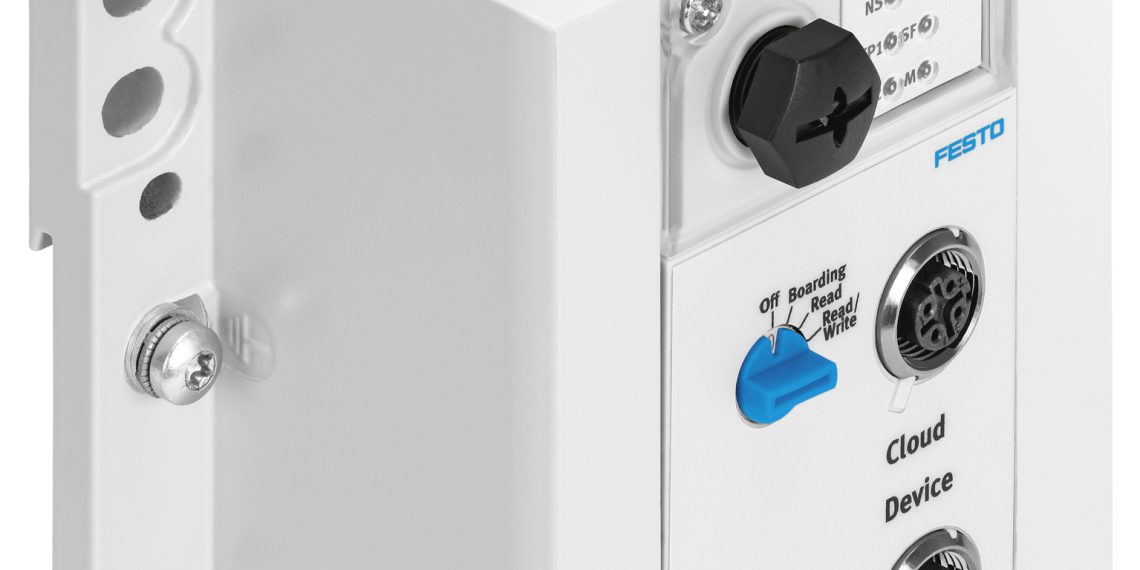What are the four factors driving Industry 4.0 and the Internet of Things? These are primarily networking, adaptability, energy efficiency and new business models. With the IoT gateway CPX-IoT, Festo is paving the way for a secure cloud solution which will enable machine and system builders as well as end customers to significantly improve their overall equipment effectiveness.
Fully networked “things” will simplify business life in the future. If the principle of the Internet of Things is applied to road traffic, improved networking would have a whole host of advantages. For example, vehicles with optimal braking performance would be more energy-efficient. Processing traffic data means that a navigation system would steer vehicles around diversions, proving its adaptability. Networking all the traffic lights together allows them to react to changing flows of traffic. This leads to brand new business models, at the heart of which is the question: how much would a driver be willing to pay for a wave of green lights?
Preparing the ground for Industry 4.0
As this vision of modern road traffic shows, the factors of networking, adaptability, energy efficiency and new business models are crucial for the era of Industry 4.0. The company is shaping this era through six key measures. Products and solutions that are fit for Industry 4.0, such as digital pneumatics with the Festo Motion Terminal, take centre stage. These are created through continuous research and development – within the company, in research networks and in the Bionic Learning Network. Optimising the supply chain makes production processes more efficient. However, Industry 4.0 could fail if the people affected by digitalisation are not prepared for it or for their role in it. It therefore makes sense to launch “Training 4.0” and “Working Environment 4.0” as well.
The underlying goal of all efforts to make Industry 4.0 a reality is the integration of different functions across system boundaries. “That is why Festo is working closely with other companies in the German Electrical and Electronic Manufacturers’ Association and on the Platform Industry 4.0 project to create a common reference architecture,” explains Dr Michael Hoffmeister, Management Expert in the newly created Digital Business section.
Festo product key
As part of this, the company is using digital twins to embed its products and solutions in the common administration shell of this reference architecture (RAMI). All products are provided with a product label including a data matrix code, known as the Festo product key, which gives access to a wealth of information. This is the key to the world of Industry 4.0.
In future, a Festo product will receive constant digital upgrades as the Festo product key will be linked to the newly created Festo App World. With the Festo App World upgrades and services for a specific component can be bought. It includes mobile apps, for the Festo Motion Terminal for example, web apps for the cloud, desktop apps, apps for programmable logic controllers and firmware apps.
IoT gateway to data analysis
Back in the here and now, the company can already present the first turnkey solution for IoT-ready components and dashboards. The IoT gateway CPX-IoT connects components and modules from the field level, such as the Festo Motion Terminal, the energy monitoring module MSE6-E2M or handling systems, to the Festo Cloud via their OPC UA interface. The data can be prepared and monitored using the cloud. This enables trend analyses to be determined, and to set up early warning systems and automatic notifications in the event of incidents. The IoT gateway provides the cloud interface to a controller, and ensures that the relevant information is communicated in the right format at the right time.
With the IoT gateway CPX-IoT, it is possible to have preconfigured dashboards for each Festo component – with additional customisation. The dashboard is viewed in the web browser and shows diagrams and traffic light indicators. Specific widgets, i.e. components of a user interface, and diagrams for energy monitoring, preventive maintenance as well as performance figures for the process and for overall equipment effectiveness improvement, provide clarity. The condition monitoring solution improves error diagnostics and fault identification, creates transparency about energy consumption, delivers clear information in graph form and makes historical data available.

















